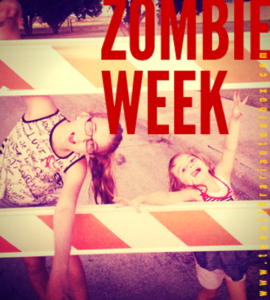Zombie Love: Why Are Zombie Things So Popular? (A guest post by Geri Diorio)
 This week we’re – and by we’re I mean people like me and author Carrie Mesrobian, not necessarily everyone here at TLT – counting down the days until The Walking Dead season finale. So while we’re counting down, we thought we would dedicate the week to zombies. We’ll here from author Carrie Mesrobian later in the week – you may have heard but she really likes The Walking Dead, particularly Daryl Dixon – and today librarian Geri Diorio is sharing with us some of her thoughts regarding the popularity of zombies.
This week we’re – and by we’re I mean people like me and author Carrie Mesrobian, not necessarily everyone here at TLT – counting down the days until The Walking Dead season finale. So while we’re counting down, we thought we would dedicate the week to zombies. We’ll here from author Carrie Mesrobian later in the week – you may have heard but she really likes The Walking Dead, particularly Daryl Dixon – and today librarian Geri Diorio is sharing with us some of her thoughts regarding the popularity of zombies.
Why do we love zombies so much? Because it seems like here in America, we REALLY love zombies. They have been all over our pop culture for more than 60 years. But if you stop to think about it, zombies have been all over humanity’s consciousness for a long time. The very idea of zombies is an old one. There seems to always have been folklore concerning the dead coming back to life. Just think of stories about vampires, ghouls, or mummies. A doctoral student I know just spent a summer in Poland digging up “vampire” graves – the final resting place of people who died in the 17th century, and were suspected of being vampires. These poor folks were buried with sharp sickles and heavy stones over their necks so that they wouldn’t rise from their graves. Humanity’s wish for life and our terror of death is very strong. We don’t want to die, but we know all things die. So if we die but come back, we are not going to look pretty. And our bodies are not going to function well. And there will be rotting. After all, people have seen have happens to meat left out too long. Thinking of all that, it is not a far leap to envisioning a zombie.
ADVERTISEMENT
ADVERTISEMENT
I wouldn’t normally commit the writer’s sin of quoting from a reference source, but the Encyclopedia Britannica’s word choice on this entry is simply too good to ignore. Regarding the etymology of “zombie’, Britannica says: “The word zombie itself entered the English lexicon in the 18th or 19th century, often attributed to British writer Robert Southey, although the idea of the walking dead had existed in various cultures for centuries.”1
So while the idea of the undead has been around for a very long time, the current pop culture idea of a zombie began in the middle of the last century and has become hugely popular with the start of the twenty first century. Popular zombie movies may have had their start in 1932 with White Zombie, starring Bela Lugosi. But the zombie movie movement continued with such films as King of the Zombies, I Walked With a Zombie, Plan 9 From Outer Space, and Tales of Terror. (This is a very incomplete list.)
In 1968, filmmaker George Romero changed the zombie pop culture game forever with his film Night of the Living Dead. While there had been dozens of zombie films previous to this one, Romero’s struck a chord with audiences. This independent film, made for $114,000, grossed more than $12,000,000. Zombies meant big box office. Romero went on to make half a dozen more “Dead” films, and his success seems to have launched a plethora of zombie love. There have been films such as Evil Dead, Zombieland, 28 Days Later, Shaun of the Dead, and Paranorman. Zombie books appeared, like The Forest of Hands and Teeth by Carrie Ryan, The Benny Imura series by Jonathan Maberry, Generation Dead by Daniel Waters, Alden Bell’s The Reapers Are the Angels, Zombies vs. Unicorns edited by Holly Black and Justine Larbalestier, and Warm Bodies (Isaac Marion) and World War Z (Max Brooks) which both were turned into movies. The Walking Dead and the new show iZombie have brought zombies to television. The Resident Evil video game series continues to be popular and zombies have even invaded casual gaming. Anyone for a round of Plants vs. Zombies? There are 5K races where runners are chased by people in zombie make up (that would make me run faster!). And even the US government got into the zombie swing of things. The Center for Disease Control has an entire plan on Zombie Preparedness. Yes, it was created initially as a tongue-in-cheek look at disaster planning, but its popularity has proven to be so big, the CDC has maintained the website. Zombies also figure into the US Armed Forces’ plans for large scale operations. There is an unclassified document, “CONOP 8888”, which the US Strategic Command used as an example of a planet-wide emergency: a zombie attack on the world.
So zombies are everywhere and we do seem to love them. Why is that? Well, if you enjoy the horror genre, you enjoy being scared. Perhaps it is the endorphin buzz you get from your fight or flight reflex being triggered. Perhaps your enjoyment comes from a more intellectual place. Maybe you enjoy the mental puzzle of figuring out how to survive a monster attack without actually getting attacked. Or maybe you have a fear of loss of technology and power, a life with no modern amenities. If the zombie apocalypse happens, power plants, water treatment facilities, and mass transit are all going away. Zombies are also useful blank slates for our subconscious. They are monsters we can project our fears onto. Disease, death, relentless pursuit, it seems like you can plug a zombie into any of these fears. Other monsters (vampires, werewolves, people with chainsaws and axes) just want to kill you – zombies want to consume your brain, devour what makes you, you; this certainly fuels a fear of loss of self. And thinking along the same lines as the US Strategic Command, zombies make a great device for an apocalyptic survival story. There is a vague menace lurching about, but we look closely only at the living folks and their stories. The survivors are the only real characters. Thus the popularity of The Walking Dead in both its comic and TV incarnations. Sure the blood and guts may attract (and repel) people, much like the fascination of looking at a wreck, but it is because of the living humans that we keep coming back to a survival story with zombies.
1 “Zombie.” Britannica School. Encyclopædia Britannica, Inc., 2015. Web. 13 Mar. 2015.

Meet Our Guest Blogger:
ADVERTISEMENT
ADVERTISEMENT
Geri Diorio is the Teen Services Librarian at the Ridgefield Library in Ridgefield, Connecticut. She loves zombies, science fiction, fantasy, the Ninth Doctor, and Game of Thrones. You can contact her on Twitter – @geridiorio
More Zombie Talk at TLT
Zombie Prom
Stephanie Wilkes talks about her annual Zombie Prom. All the cool undead kids are doing it.
TPiB: It’s a Dead Man’s Party
Cool programming ideas you can do in your library whether you are a zombie or just running from them.
TPiB: Bring Out Your Dead, zombie party take 2
Zombies VS. Humans Lock-In, with a Doctor Who twist
Top 10 Survival Tips I Learned from Reading YA
Look, my chances are not good in a post-apocalyptic world. I like to lie in bed, read a book and drink pop with either my air conditioning or heater on. I don’t like to cook. I do not take my indoor plumbing for granted. Should the apocalypse happen, however, I have learned these 10 tips for survival which I am now going to share with you. See, even zombie books are educational.
What’s the Deal with Zombies Anyway?
Zombie Book Reviews at TLT:
Alice in Zombieland by Gena Showalter
This is Not a Test by Courtney Summers
The Infects by Sean Beaudoin
Fire and Ash by Jonathan Maberry
Contaminated by Em Garner
Sick by Tom Leveen
Zombie Baseball Beatdown by Paolo Bacigalupi
Monsters by Ilsa J. Bick
Eat, Brains, Love by Jeff Hart
Filed under: Zombie Week, Zombies
About Karen Jensen, MLS
Karen Jensen has been a Teen Services Librarian for almost 30 years. She created TLT in 2011 and is the co-editor of The Whole Library Handbook: Teen Services with Heather Booth (ALA Editions, 2014).
ADVERTISEMENT
ADVERTISEMENT
SLJ Blog Network
The Moral Dilemma of THE MONSTER AT THE END OF THIS BOOK
Cover Reveal and Q&A: The One and Only Googoosh with Azadeh Westergaard
K is in Trouble | Review
Fighting Public School Book Bans with the Civil Rights Act
ADVERTISEMENT







